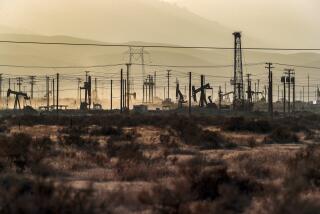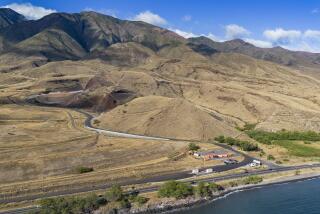New Federal Requirement Is Applied to McColl Case
The U.S. Environmental Protection Agency has ruled that extra precautions costing at least $5 million are needed at the landfill designated to receive soon-to-be-excavated waste from the McColl dump in Fullerton, federal officials said Wednesday.
The ruling is part of a policy decision affecting future “superfund” hazardous waste cleanups nationwide, said Keith Takata, branch chief for the EPA’s “superfund” office in San Francisco.
New Administrator Takata said the decision was made by Lee Thomas, who has been nominated to replace William Ruckelshaus as EPA administrator. Thomas, he said, decided that any waste removed under the agency’s “superfund” cleanup program must be deposited in landfills that meet new, stringent regulations included in a recently reauthorized federal environmental protection law.
Excavation of the McColl waste, scheduled to begin next month, will not be delayed by the change in rules, Takata said.
The regulations require landfills built or expanded after May to be equipped with double liners, which would detect and collect runoff from the hazardous waste before it can leach into the soil. Although existing landfills are not legally affected, Thomas has required the improvements at any facility accepting waste from a “superfund” cleanup, Takata said. “Whether or not it’s legally required, he wants to see it as a policy,” Takata said of Thomas’ decision.
Takata said that Thomas made the policy decision in reviewing the law’s effect on several cleanup projects, including McColl, referred to him after President Reagan reauthorized the legislation in November.
But the new federal edict did not please Tom Bailey, a top state health department toxics official, who said the double liners may be an unnecessary precaution for McColl wastes.
“We can understand why he (Thomas) made the decision, but it doesn’t make a whole lot of sense at this time for the McColl waste,” said Bailey, program management chief with the health department’s toxic substances control division. The McColl waste is mostly solidified--”almost a carbon, it’s so dry,” he said. “I could understand it if it was highly liquefied, if it might leach (into the soil). But that doesn’t apply to McColl.”
Could Be $7 Million The McColl cleanup was initially projected to cost $21.5 million, with 90% coming from the “superfund” and the rest from the state. Takata estimated that the new regulations would raise the cost of the cleanup by $5 million to $6 million, but Bailey placed the figure at $7 million.
The new requirement is the latest hitch in the long-delayed cleanup of McColl’s World War II refinery acid waste, buried beneath a field and golf course in a Fullerton residential neighborhood. The cleanup, which will involve excavating the waste and trucking it to the Casmalia Resources landfill in northern Santa Barbara County, is scheduled to begin next month.
According to Takata, however, the excavation can proceed on schedule because the unearthed waste can be stored in a temporary facility at Casmalia until the double liner is completed. Bailey said it will take at least four weeks to construct the double liner.
Bailey said the Department of Health Services has not yet decided how to respond to the EPA edict, adding that a chief unanswered question is who will pay for the improvements at Casmalia. “There are only two answers: the federal government alone, or the state and federal governments combined,” he said. The state has agreed to pay 10% of the $21.5-million cleanup cost.
But Takata said the state has been told that it will have to pay 10% of the added cost as well.
The new federal regulations are included in the reauthorization of the Resource Conservation and Recovery Act, the “cradle-to-grave” environmental law intended to track hazardous waste as it is generated, stored, transported, treated and disposed of.
Takata said Thomas reasoned that even though the new regulations did not legally apply to many ongoing or planned “superfund” projects, there was a greater issue involved, that of requiring the most stringent environmental precautions to government-financed cleanups.
“What we want to attain is some sense of finality, that we do a cleanup once and forever,” Takata said. “Congress decided and the President agreed” in adopting the new regulations that “greater protection of landfills is needed through this double-liner requirement. Then we (EPA) ought to try to implement it, even if it is not required legally, and we do that by imposing the requirements on the government’s own cleanups.”
Takata said he did not know how many “superfund” projects will be affected by the new policy. There are only three ways to clean up a contaminated site--”you can leave it there, you can treat it, or you can dig it up and haul it away,” he said. “A lot (of cleanup projects) have to consider digging it up and taking it away.”
Bailey said the state is not considering changing landfills for the McColl waste because other facilities would have to be similarly improved to meet the federal law. The new double-liner facility at Casmalia will be built to accept only McColl wastes, he said.
Kenneth Hunter Jr., manager and principal general partner of Casmalia Resources, could not be reached for comment Wednesday. He earlier had stated that he did not want to accept the McColl waste if new regulations resulted in higher costs or complications.
The Casmalia landfill, in the remote hills west of Santa Maria, sits atop “impermeable” shale in an area with no groundwater, according to a company brochure.
However, the 250-acre dump site has been a recent source of controversy. Nearby residents have complained of smells from the landfill, and have expressed fears that their health and property values are being affected. The two-classroom Casmalia elementary school closed for two days in late November after odors caused nausea and eye irritation. Hunter has insisted that his landfill is not to blame.
The McColl dump was created in the mid-1940s when oil companies, producing aviation fuel for World War II, deposited waste materials in 12 pits operated by a man named Eli McColl in then-rural Fullerton. Now, the dump site is bordered on three sides by upper-middle-class homes and a golf course on the fourth.
State health officials have determined that the dump contains sulfuric acid, sulfur dioxide, benzene and arsenic, and the fumes have caused surrounding residents to suffer from headaches, nausea and respiratory problems.
More to Read
Sign up for Essential California
The most important California stories and recommendations in your inbox every morning.
You may occasionally receive promotional content from the Los Angeles Times.










